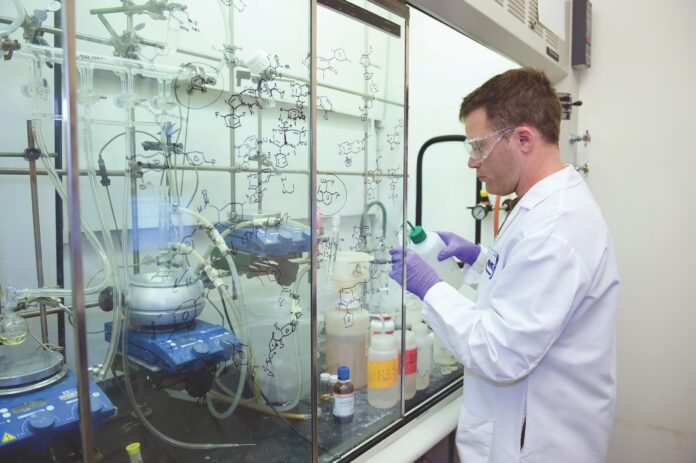With its long-anticipated acquisition of Horizon Therapeutics wrapped up last month, Thousand Oaks pharma giant Amgen Inc. is incorporating Horizon’s drug development programs into a new business line for rare disease therapies.
Meanwhile, along its more traditional business lines, Amgen late last month won approval from the United States Food and Drug Administration to market a drug it developed that is similar to Johnson & Johnson’s blockbuster drug Stelara.
Amgen’s new rare disease business line was officially unveiled during the company’s third quarter earnings teleconference call on Oct. 31.
Amgen Chief Executive Robert Bradway introduced the business line in his opening comments as “a newly created rare disease business that is now the fourth leg of Amgen’s commercial stool, alongside our inflammation, oncology and general medicine businesses.”
Bradway then introduced Vikram Karnani as the leader of that business. Karnani held several executive posts at Dublin-based Horizon Therapeutics prior to its merger with Amgen, including president of global commercial operations.
“We’re excited to bring together Horizon’s medicines, pipeline and rare disease expertise with Amgen’s history of leadership in inflammatory diseases, global infrastructure and world-class biologic capabilities,” Karnani said before briefing analysts on the call on the status of several drugs Horizon had on the market or in development.
Chief among those drugs is Tepezza, the first and only medicine so far approved for the treatment of thyroid eye disease and one of the drugs at the center of the scrutiny that federal regulators applied to the merger plan. Karnani said that during the third quarter, Tepezza generated $453 million in sales, representing 2% quarter-over-quarter growth.
“We are confident that now as we have officially joined forces and have on-boarded the full commercial team, we will make significant progress in advancing this important product over time to patients,” Karnani said.
Another major drug Horizon had on the market was Krystexxa, the only medicine so far approved to treat uncontrolled gout; Karnani said that drug had $253 million in third quarter sales, an increase of 32% over the same quarter last year.
Horizon’s other drugs that have made it to market generated about $240 million in third quarter sales, he added.
“Looking ahead, we are excited to work together by leveraging Amgen and Horizon’s combined capabilities to ensure our medicines reach more patients even faster who are suffering from serious and rare diseases globally,” he said.
Earnings
As for Amgen overall, third quarter revenues increased 4% to $6.9 billion in comparison to the same quarter last year.
In his comments to analysts in the conference call, Bradway said volume increased 11% globally, which represents the company’s fourth consecutive quarter of double-digit volume growth.
Bradway noted that seven of the company’s medicines generated record sales during the quarter.
Among the best performers were:
• Blincyto (used to treat patients with a precursor form of acute lymphoblastic leukemia), which posted a 55% sales jump in the third quarter compared to the same quarter last year;
• Evenity (used to treat osteroperosis in women after menopause), which saw a 53% year-over-year growth in sales; and
• Repatha (used in adults with cardiovascular disease to reduce the risk of heart attack, stroke, and certain types of heart surgery), which recorded a 31% growth in sales from the same quarter last year.
Amgen’s net income available to shareholders during the third quarter was $1.7 billion, down from $2.1 billion for the same quarter last year. Amgen attributed much of this drop to a net impairment charge of about $650 million following a decision to discontinue development of a drug to treat prostate cancer and move ahead with development of an alternate drug.
The company also issued updated guidance for full-year earnings performance. According to that guidance, total revenue is expected to come in between $28.0 and $28.4 billion, while capital expenditures were expected to total around $950 million. Total share repurchases for the year are not to exceed $500 million, the company said.
Amgen shares fell on the day of the earnings release (Oct. 31) to $255.70 from $263.19, but regained that lost ground in two days. The share price closed at $264.27 on Nov. 27.
New drug
On the same day as the earnings release and conference call, the Food and Drug Administration approved Amgen’s drug Wezlana for commercial use. Wezlana is a “biosimilar” drug for Stelara, the blockbuster drug from New Brunswick, New Jersey-based Johnson & Johnson. Stelara, which came on the market in 2009, has been Johnson & Johnson’s top-selling drug since 2019, with sales reaching $9.7 billion last year.
According to the Food and Drug Administration’s website, a biosimilar drug is highly similar to and has no clinically meaningful differences from an existing agency-approved biologic, called a reference product. Compared with their reference product, biosimilars are made with the same types of living sources and generally have the same strength, dosage, potential treatment benefits and side effects.
Unlike generic versions of a drug, biosimilars generally have more complex active ingredients and therefore are not exact copies of the reference drug.
In an era of frequent shortages of crucial pharmaceutical products, biosimilars provide a more diverse supply chain and more competition, as well as enabling other pharma companies to share in the revenue for a highly lucrative general therapy for a particular disease or condition.
“Today’s approval exemplifies the FDA’s longstanding commitment to support a competitive marketplace for biological products,” Sarah Yim, director of the agency’s office of therapeutic biologics and biosimilars, said in the agency’s announcement. “This approval can empower patients by helping to increase access to safe, effective and high-quality medications at potentially lower cost.”
